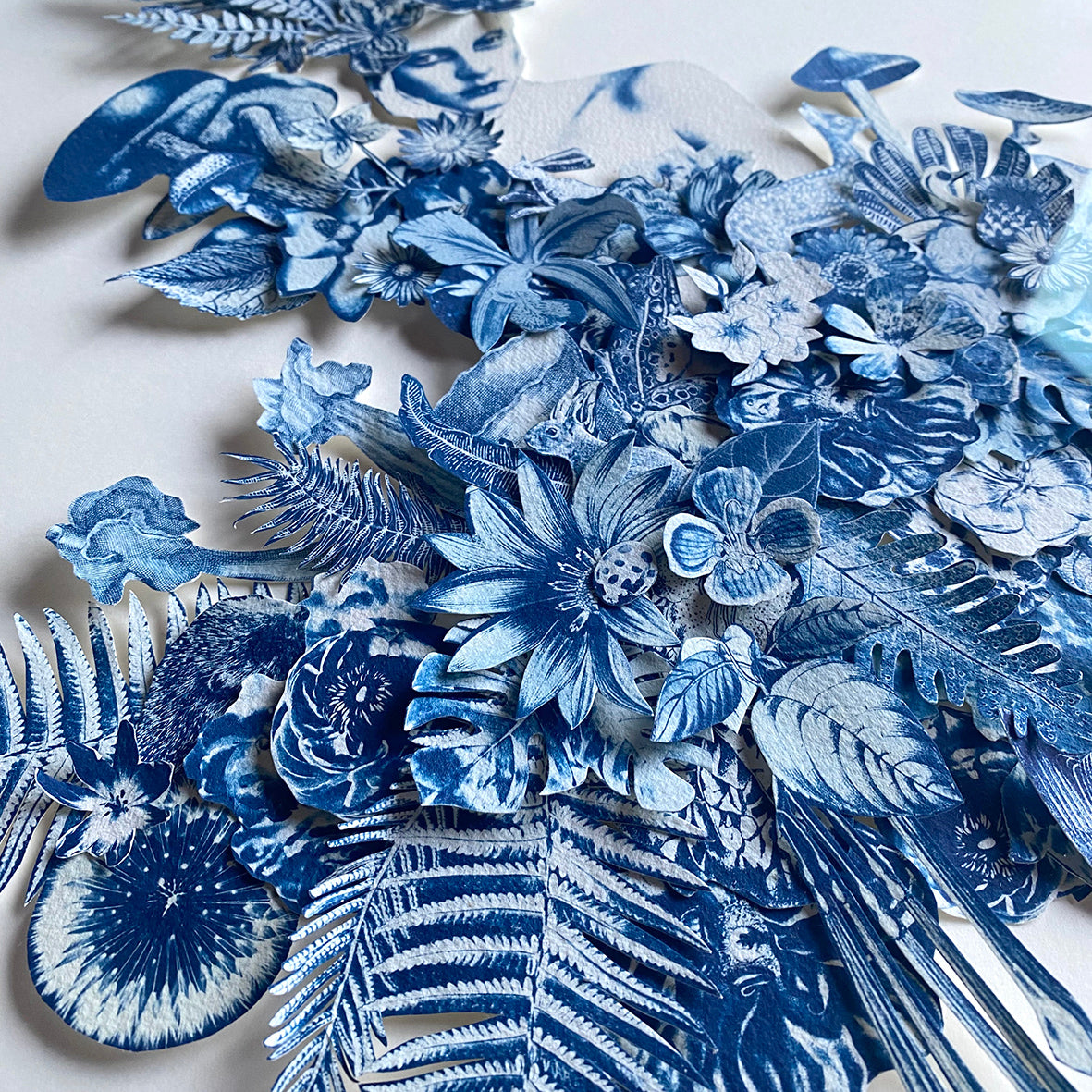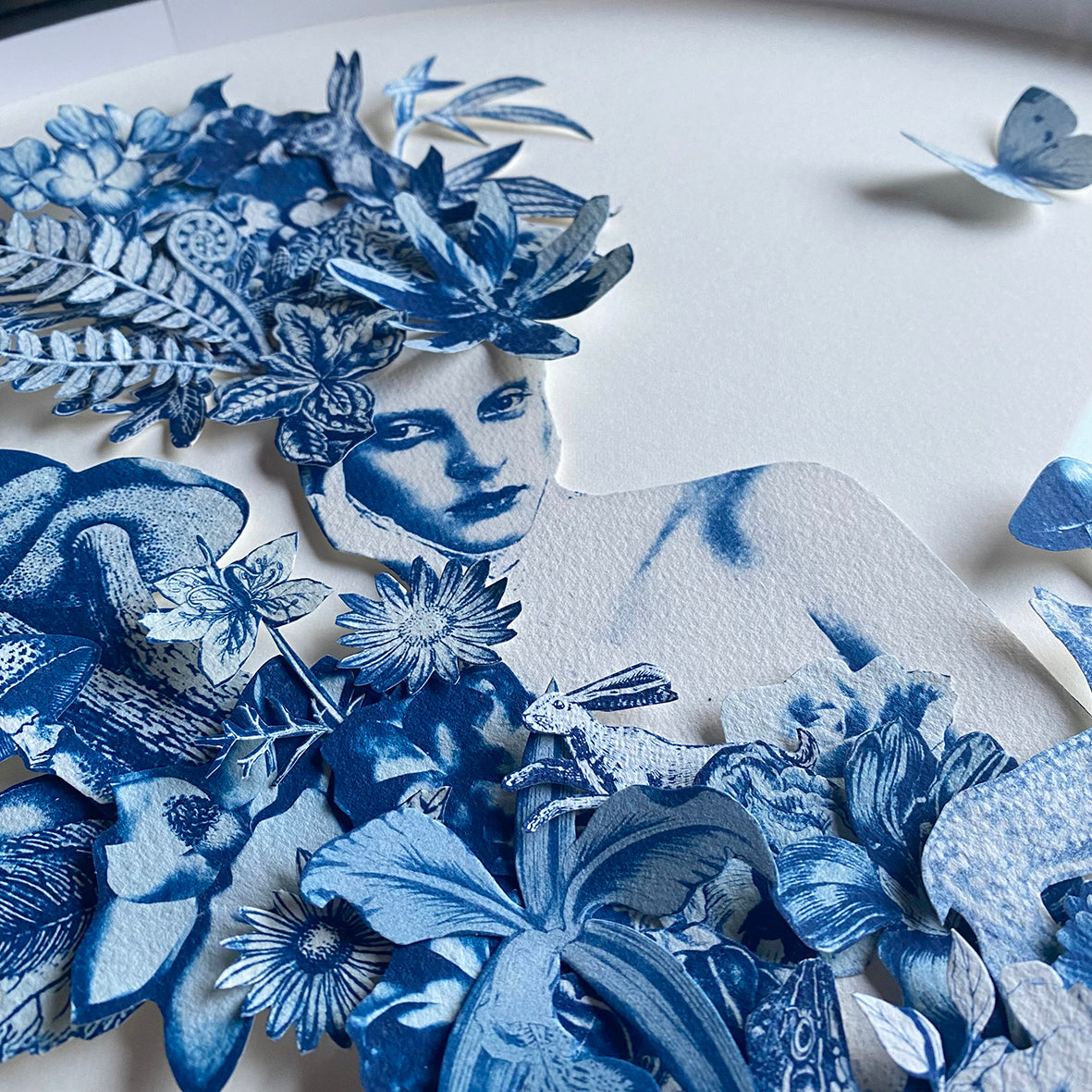Beatrix's Fantastical Wold (Ode to Beatrix Potter)
Beatrix's Fantastical Wold (Ode to Beatrix Potter)
Title | BEATRIX’S FANTASTICAL WORLD (ODE TO BEATRIX POTTER) Type | Original 3-D papercut cyanotype
Inspiration | Beatrix Potter
Year | 2023
Materials | Cyanotype, 3D paper cut, multi layered collage, handmade paper 23.6in Frame diameter x 1.2in frame depth
Inspiration-
Inspired by English author, illustrator, conservationist and mycologist Beatrix Potter. Beloved by generations of readers, she was best known for her children's books, such as "The Tale of Peter Rabbit." Growing up near The Lake District, I enjoyed visiting Potter’s home and fully immersed myself in the world she created in her children's collection. I made this piece as a homage to her.
Potter had a deep appreciation of nature and her passion for the natural world played a major role in her life and work. She was an advocate for preserving the natural world and her books featured themes of conservation and environmentalism. The title of this artwork creates a dreamlike or fantastical world inspired by Beatrix Potter's stories, with her characters and landscapes reimagined in new and unexpected ways.
Throughout her life, Potter collected and studied mushrooms and made detailed drawings and watercolour paintings of them. She was a member of the British Mycological Society, her illustrations and scientific drawings of mushrooms and other fungi were highly respected by her peers. She was particularly interested in the life cycle of mushrooms and the relationship between the fruiting body and the underground mycelium. Her illustrations and observations were used to support her theories about the life cycle of mushrooms, which were ahead of their time.
Potter's work on mushrooms and other fungi was not widely recognized during her lifetime, but her illustrations and scientific notes have since been rediscovered and are now considered an important contribution to the field of mycology. In addition to her artistic talents, her scientific observations and illustrations are considered valuable contributions to the field of mycology, and have been republished in several books, including "The Journal of Beatrix Potter" and "The Fungi drawings of Beatrix Potter".
Beatrix Potter was deeply connected to the Lake District, an area in northwest England that she loved and spent much of her life. She had a holiday home in the Lake District called Hill Top, which she bought in 1905 and used as a base for her study of the local flora and fauna. The Lake District provided her with a great deal of inspiration for her illustrations and stories. Many of her children's books, such as "The Tale of Peter Rabbit," are set in the area, and her illustrations depict the landscapes, plants and animals of the
region. She also wrote several books set in the Lake District, such as "The Tale of Tom Kitten" and "The Tale of Jemima Puddle-Duck".
In addition to her literary works, she was also a keen gardener and farmer, and she used her experience to create a beautiful garden at Hill Top, which is now open to the public. She also purchased additional farms in the area, and became a respected farmer and breeder of Herdwick sheep. Overall, the Lake District and its landscapes, flora and fauna played a big role in her life and work, and her love for the area is evident in her books and illustrations.
Beatrix Potter was a strong-willed and independent woman who lived during a time when women were not encouraged to pursue careers or interests outside of the home. Despite this, she was able to achieve a great deal of success as an author, illustrator, and mycologist. Her children's books were popular and critically acclaimed, and her illustrations and scientific drawings of mushrooms and other fungi were highly respected.
Some argue that her books, especially the ones that feature the strong-willed and independent characters like Mrs. Tiggy-Winkle, and Jemima Puddle-Duck, could be seen as a representation of feminist ideals and the empowerment of women. She also wrote about strong-willed and independent female characters in her children's books, which could be seen as an early representation of feminist ideals.
Overall, while her work and her life can be seen as an inspiration for women and girls, it is not clear if she considered herself a feminist or if she actively advocated for women's rights. In addition, she was a strong-willed and independent woman who did not let societal expectations and gender roles hold her back from pursuing her passions. She was able to overcome the obstacles and succeed in a field that was traditionally dominated by men.
Technique-
Beatrix’s Fantastical World (Ode To Beatrix Potter) was created by constructing a hand-cut collage using female photographic portraiture combined with photograms, photographs and illustrations of flora, fauna, animals and insects from my private collection, gathered, pressed and preserved from my childhood garden and using scientific textbooks and Potter's Peter Rabbit collection as reference.
After coating the handmade paper with light-sensitive chemistry, it is left to dry in a dark room. The large-scale negatives are contact printed onto the paper by exposure to daylight (UV rays) for up to a month, depending on the weather, the seasons and the intensity of light. The prints are then processed by thoroughly washing in water to remove any unexposed solution, then be hung to dry, developing to full density Prussian blue after 24 hours. Once dry the individual parts are cut out and collaged together to create a multi layered, 3D artwork.
All my paper is handmade using cotton rags, they are ripped, blended and then made into pulp, mixing in a binder of gelatin before placing into a trough ready to be added to the paper moulds. Once the pulp is
sitting on the mesh of the mould, the water is drained, then the paper pulp sheet is laid onto pieces of felt and weights are pressed to draw out the excess water and help bind the fibres. Once set the sheets are hung to dry for a week or so until they are ready for use.
My unique portraits have a distinctive painterly characteristic made by embracing technological advances in large-scale negative printing whilst staying true to the purest and earliest forms of photographic techniques. I examine complex interactions between human experience, environment, materials used, light and time combined with deconstructing and reconstructing images to create intriguing, surrealistic stories.
Each piece is constructed from scratch, fabricating the paper foundation, starting the life cycle, building up the layers creating an evolving luminous landscape. Each piece of handmade paper is a work of art in itself, the recycled cotton rag pulp creates the base structure upon which to let my pieces develop. I love watching the way the tones of the cyanotype chemicals develop on the porous surfaces, the way they evolve during exposure to natural sunlight and seeing the colour intensify when washing in water.
It is a marriage of natural phenomena and artist intent, a harmonisation of the natural and human worlds. I became more aware of how I wished to use these experiments and research within my pieces as a metaphor and a commemoration of mother nature and science's astounding power.
These ideas are reflected throughout my working methodology from the creation of the paper (handmade from recycled cotton rags and circular moulds), within the construction of the images themselves, (featuring circular motifs and objects from petri dishes to the moon), the process of exposing using natural light and washing in moonlight, in all weather conditions throughout the seasons, and the circular theme carries through to framing the finished pieces in hand made round frames.
The repeating shapes and patterns represent life cycles, borne from human touch and made from recycled materials, taking on new lives once coated with the light-sensitive solutions and exposed to the elements. The process of capturing Mother Nature and creating artworks using her power is a marriage of natural phenomena and artistic intent.
Paper
Handmade recycled cotton rag paper:
320gsm / 100% Cotton Rag / Recycled / Acid Free / Medium Rough
Mount
We use float mounting for all of our framed cyanotypes. The artwork floats above a
snow-white, Larson- Juhl 1400 microns (8001 white core mount board), to showcase the paper texture and deckled edging.
Framing
Framed artwork will arrive ready to hang.
Each frame is handmade by our London based design team.
All frames come with gallery spec, 2mm thick Artglass AR70 / 3mm anti-reflective/ 79% UV protected glazing as standard.
If clients would like a bespoke frame, please let me know as I can have them made in alternative colours, gilding and glazing options.
Couldn't load pickup availability
































